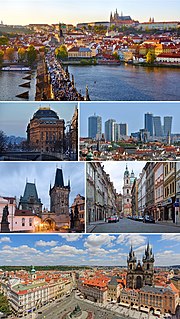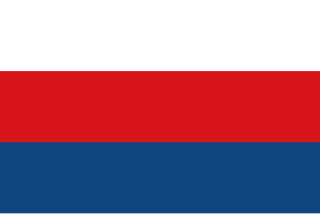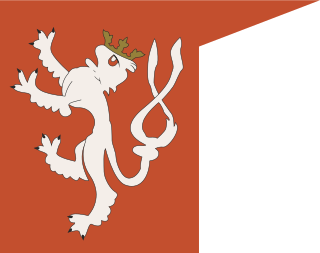
Bohemia is the westernmost and largest historical region of the Czech lands in the present-day Czech Republic. In a broader meaning, Bohemia sometimes refers to the entire Czech territory, including Moravia and Czech Silesia, especially in a historical context, such as the Lands of the Bohemian Crown ruled by Bohemian kings.

Czechoslovakia, or Czecho-Slovakia, was a sovereign state in Central Europe that existed from October 1918, when it declared its independence from the Austro-Hungarian Empire, until its peaceful dissolution into the Czech Republic and Slovakia on 1 January 1993.

Czech, historically also Bohemian, is a West Slavic language of the Czech–Slovak group. Spoken by over 10 million people, it serves as the official language of the Czech Republic. Czech is closely related to Slovak, to the point of mutual intelligibility to a very high degree. Like other Slavic languages, Czech is a fusional language with a rich system of morphology and relatively flexible word order. Its vocabulary has been extensively influenced by Latin and German.

Moravia is a historical region in the Czech Republic and one of the historical Czech lands, together with Bohemia and Czech Silesia. The medieval and early modern Margraviate of Moravia was a crown land of the Lands of the Bohemian Crown, an imperial state of the Holy Roman Empire, later a crown land of the Austrian Empire and briefly also one of 17 former crown lands of the Cisleithanian part of the Austro-Hungarian Empire from 1867 to 1918. During the early 20th century, Moravia was one of the five lands of Czechoslovakia from 1918 to 1928; it was then merged with Czech Silesia, and eventually dissolved by abolition of the land system in 1949.

Prague is the capital and largest city in the Czech Republic, the 14th largest city in the European Union and the historical capital of Bohemia. Situated in the northwest of Czechia on the Vltava river, Prague is home to about 1.3 million people, while its metropolitan area is estimated to have a population of 2.6 million. The city has a temperate climate, with warm summers and chilly winters.

Charles University, known also as Charles University in Prague or historically as the University of Prague, is the oldest and largest university in the Czech Republic. Founded in 1348, it was the first university in Central Europe. It is one of the oldest universities in Europe in continuous operation. Today, the university consists of 17 faculties located in Prague, Hradec Králové and Pilsen. Its academic publishing house is Karolinum Press. The university also operates several museums and two botanical gardens.
The Czechs or the Czech people, are a West Slavic ethnic group and a nation native to the Czech Republic in Central Europe, who share a common ancestry, culture, history, and Czech language.

The Protectorate of Bohemia and Moravia was a protectorate of Nazi Germany established on 16 March 1939 following the German occupation of Czechoslovakia on 15 March 1939. Earlier, following the Munich Agreement of September 1938, Nazi Germany had incorporated the Czech Sudetenland territory as a Reichsgau.

According to the Act no. 129/2000 Coll. on higher-level territorial self-governing units, which implements Chapter VII of the Czech Constitution, the Czech Republic is divided into thirteen regions (kraje) and one capital city with regional status as of 1 January 2000. The older administrative units seventy-six districts are still recognized and remain the seats of various branches of state administration, such as the judicial system.

The Czech national football team represents the Czech Republic in international football, and are controlled by the Football Association of the Czech Republic, the governing body for football in the Czech Republic. Historically, the team participated in FIFA and UEFA competitions as Bohemia, Austria-Hungary and Czechoslovakia, finishing second at the 1934 and 1962 World Cups and winning the European Championship in 1976.
The Dissolution of Czechoslovakia, which took effect on 1 January 1993, was an event that saw the self-determined split of the federal state of Czechoslovakia into the independent countries of the Czech Republic and Slovakia. These entities had arisen before as the Czech Socialist Republic and the Slovak Socialist Republic in 1969 within the framework of a federal republic.

The Football Association of the Czech Republic or colloquially the Czech Football Association is the governing body of football in the Czech Republic, based in Prague. It organizes the lower-level league competitions in the country, the Czech Cup, and the Czech Republic national football team.

The koruna is the currency of the Czech Republic since 1993, and in English it is sometimes referred to as Czech crown or Czech krone. The koruna is one of European Union's 11 currencies, and the Czech Republic is legally bound to adopt the euro currency in the future.

The Kingdom of Bohemia, sometimes later in English literature referred to as the Czech Kingdom, was a medieval and early modern monarchy in Central Europe, the predecessor of the modern Czech Republic. It was an Imperial State in the Holy Roman Empire, and the Bohemian king was a prince-elector of the empire. The kings of Bohemia, besides Bohemia, also ruled the Lands of the Bohemian Crown, which at various times included Moravia, Silesia, Lusatia, and parts of Saxony, Brandenburg, and Bavaria.

The Czech First League, known as the Fortuna liga for sponsorship reasons, is a Czech professional league for football clubs. At the top of the Czech football league system, it is the country's primary football competition. It is contested by 16 clubs, operating a system of promotion and relegation with the Czech National Football League. Since 2018/19 seasons run from July to May, with teams playing 30 games each. Then teams are divided into three groups playing superstructure for final positions. The league is currently ranked 13th in Europe in the UEFA league rankings.
The list of Czech films is a list of films made in the Czech lands from 1898 to the present. After 1930 some were with Czech sound, and after 1947 some were in colour. The list is ordered by year of release.

Petra Kvitová is a Czech professional tennis player. Known for her powerful left-handed groundstrokes and variety, Kvitová turned professional in 2006 and has won 27 career singles titles, two of which are Grand Slam titles, the Wimbledon Championships in 2011 and in 2014. She also won a bronze medal at the 2016 Rio Olympics. Her career-high ranking of world No. 2 was reached on 31 October 2011 and as of 5 August 2019, she is ranked world No. 6 by the Women's Tennis Association (WTA). As such, Kvitová is currently the highest-ranked left-handed player in the world and the second highest-ranked Czech, behind Karolína Plíšková.

The National Library of the Czech Republic is the central library of the Czech Republic. It is directed by the Ministry of Culture. The library's main building is located in the historical Clementinum building in the centre of Prague, where approximately half of its books are kept. The other half of the collection is stored in the district of Hostivař. The National Library is the biggest library in the Czech Republic, housing around 6 million documents. The library has around 60,000 registered readers. As well as Czech texts, the library also stores older material from Turkey, Iran and India. The library also houses books for Charles University in Prague.

















